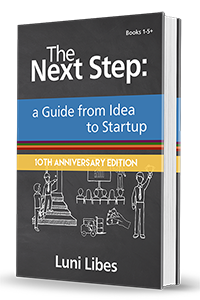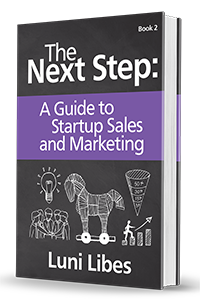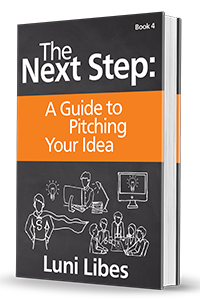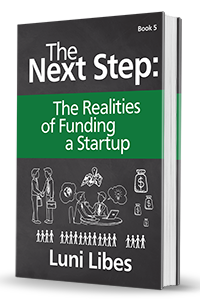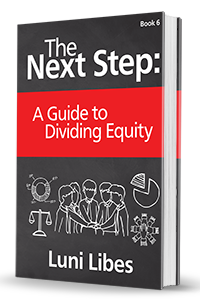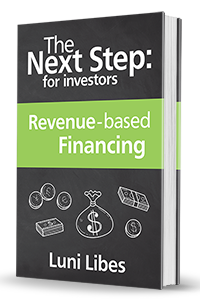The world is full of problems…
A GREAT PITCH starts out explaining a problem that needs a solution. Before explaining anything about your specific solution, you need the audience to understand the scope of the problem you are solving and, specifically, to understand who has this problem.
RULE 16:
Often, in pitches, the problem is presented simply and objectively:
Ensibuuko—[The problem, first draft]
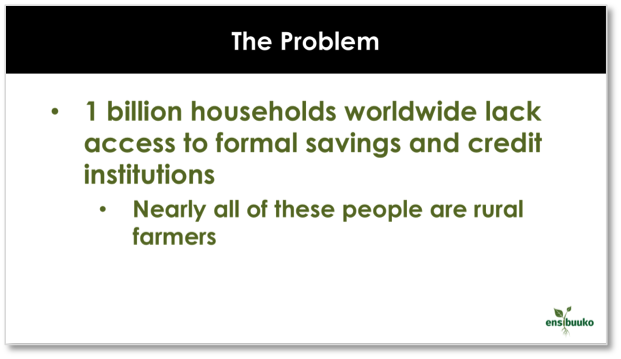
“Worldwide, more than half of the world population, over one billion households, does not have a bank account. Nearly all of these are rural smallholder or subsistence farmers.”
While the above slide does explain the problem and the people experiencing the problem, it is hard to imagine anyone being excited by the words on that slide. It is far easier to imagine an audience being bored as they listen to facts and figures like these.
Furthermore, given a slide with nothing but text, the audience will no doubt try and read that text. The text and the script are almost identical, and thus one or the other isn’t required. You want the audience paying attention to you more than your slides, hence keep the text on your slides to a minimum.
Below is an improved version of the “problem” slide:
Ensibuuko—[Problem, second draft]
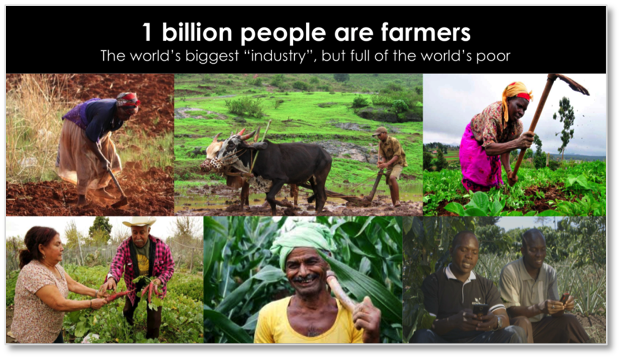
“Worldwide, one billion people are smallholder farmers. Farming is in fact the world’s biggest industry. The problem is that nearly all of the farmers are ‘smallholder’ farmers with little savings. The local banks don’t give them the loans they need to grow their businesses.”
This version covers the same facts but as a story. It would be even more of a story if it talked about one specific farmer, but that style of, “Meet Bo, a smallholder farmer from Uganda,” is common enough now that it has become yet-another pitch cliché.
Instead, in this revision, the slide begins to bring us into the shoes of the smallholder farmers by using images of their daily lives. This slide removes 90% of the text from the first draft and simplifies the facts down to “people” (a simple concept) vs. “households” (a far more nuanced measure) and introduces the “world’s biggest industry” factoid, to add an additional feeling of scale to this problem and make it clear that this is a very large, important problem being discussed.
With the limited text and series of images, the audience has few distractions. They can’t read ahead. They can’t stop to think. They are carried along by the presenter and into the problem space.
When creating your own story, if you have existing customers, tell one of their true stories. If you haven’t closed any customers yet, tell a story from your market research. If none of those stories are compelling then, like in the example above, tell the story of the whole industry. But do note, if you don’t have a story to tell from an actual or potential customer, you might need to reconsider your business.
If you have a real story to tell and if you tell the story well, the audience will relate to this customer, or at least empathize with this customer’s pain. In some cases, you may need a few variations of your pitch, with different customer stories to best match your perspective audience. And if time allows, you might want to introduce multiple customers into your story, to show how your company is solving a breadth of problems.
Writing stories is an art, and picking just the right story to pitch your company will take some creativity, multiple iterations, and much fine tuning.



